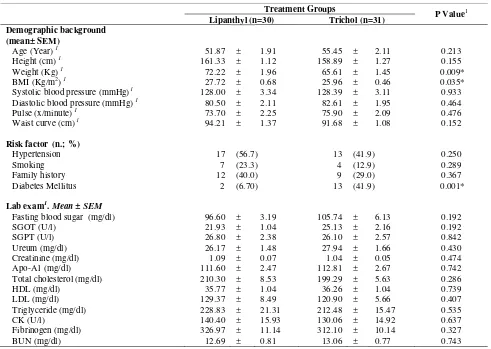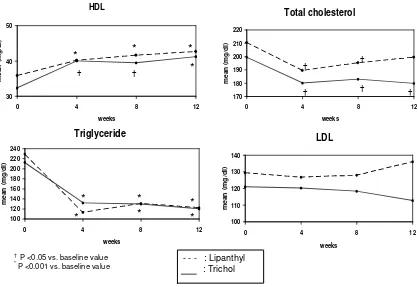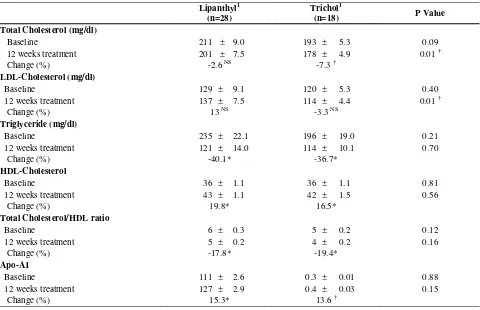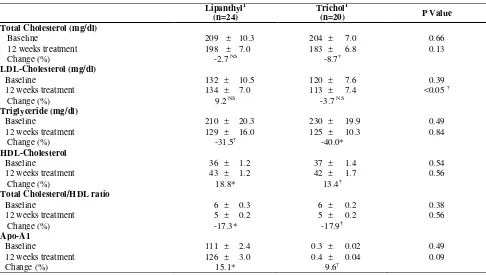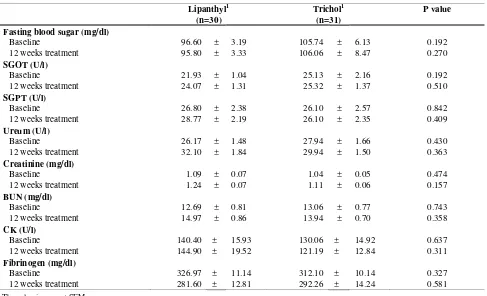Efficacy and tolerability of 12-weeks treatment with lipanthyl supra or trichol
in Indonesian patients with dyslipidemia
Siti Fadilah Supari, Sunu Budhi Raharjo, Lies Dina Liastuti, Adnil Basha
Abstrak
Hubungan antara dislipidemia dengan terjadinya aterosklerosis dan penyakit jantung koroner sudah terbukti dalam banyak studi. Penelitian ini bertujuan mengevaluasi perubahan kadar lipid setelah pemberian fenofibrat produksi lokal (trichol) atau lipanthyl supra pada pasien dislipidemia di RSJPD Harapan Kita secara teracak (randomized) dan tersamar (double-blinded). Sebanyak 68 pasien dengan kadar HDL40 mg/dL; trigliserida 200–600 mg/dl; dan/atau LDL130 mg/dL diikutsertakan sebagai subyek penelitian. Subyek dirandomisasi untuk mendapatkan lipanthyl 160 mg satu kali/hari atau trichol 300 mg satu kali/hari. 61 pasien mengikuti uji klinik ini sampai selesai. Kadar lipid sebelum terapi (data dasar) dan 4, 8, 12 minggu setelah terapi diperiksa dan dianalisis. Dibandingkan dengan data dasar, terapi selama 12 minggu mampu meningkatkan kadar HDL sebesar 18.8% dan 14.3% (P<0.001), menurunkan kadar trigliserida sebesar 38.2% dan 37.2% (P<0.001), meningkatkan kolesterol total sebesar 3.1% (P=0.114) dan 8.4% (P<0.005), menurunkan rasio kolesterol total/HDL sebesar 17.6% dan 18.4% (P<0.001), meningkatkan ApoA-1 sebesar 15.0% dan 9.7% dan menurunkan kadar fibrinogen sebesar 13.8% dan 6.4% untuk lipanthyl dan trichol. Tidak ada perbedaan yang bermakna pada kadar LDL untuk kedua grup. Hal yang menarik adalah trichol mampu menurunkan tingkat kolesterol total (P<0.05) lebih baik dibanding lipanthyl. Efek samping yang diakibatkan oleh kedua perlakuan tidak berbeda bermakna. Terapi dengan trichol dan lipanthyl mampu memperbaiki kadar lipid pasien dislipidemia. Kedua obat meningkatkan kadar HDL dan menurunkan kadar trigliserida secara bermakna. Selain itu, penurunan kadar kolesterol total secara bermakna dapat dicapai setelah 12 minggu terapi dengan trichol tetapi tidak dengan lipanthyl. (Med J Indones 2007; 16:159-67)
Abstract
The relation of dyslipidemia with the development and progression of atherosclerosis and coronary artery diseases has been demonstrated. This study compared the lipid modifying effects of locally-manufactured fenofibrate (trichol) versus lipanthyl supra in a randomized double-blind controlled study. A total of sixty-eight patients with levels of HDL cholesterol ≤40 mg/dL; triglyceride of 200–600 mg/dL; or LDL of ≥130 mg/dL were recruited to this study and were randomized to either receive trichol 300 mg once daily or lipanthyl 160 mg once daily. Sixty one patients completed the study. Lipid levels before and 4, 8, and 12 weeks after the treatments were measured and analyzed. Compared to baseline values, 12-weeks treatment with either lipanthyl or trichol significantly increased plasma HDL by 18.8% and 14.3% respectively (P<0.001), decreased triglyceride by 38.2% and 37.2% (P<0.001), but with no significant change in LDL levels. Furthermore, we observed a decreased in total cholesterol levels compare to baseline by 8.4% (P<0.05) and 3.1% (P=0.114), in total cholesterol/ HDL ratio by 17.6% and 18.4% (P<0.001), in fibrinogen level by 13.8% and 6.4% and an increase in ApoA-1 by 15.0% and 9.7% for lipanthyl and trichol, respectively. Interestingly, the decrease in total cholesterol level is significantly higher in trichol than lipanthyl groups (P<0.05).The adverse events of both treatments were comparable. The lipid-modifying effects of 300 mg daily dose of trichol is comparable to that of 160 mg daily dose of lipanthyl. Both drugs efficiently increased the plasma HDL levels and decreased plasma triglycerides concentration. Besides, a significant reduction of total cholesterol was achieved after 12 weeks treatment with trichol, but not lipanthyl. (Med J Indones 2007; 16:159-67)
Keywords: dyslipidemia, fenofibrate
Coronary artery disease (CAD) is the leading cause of mortality worldwide. Dyslipidemia has long been recognized as one of the major risk factors for this
disease and there has been a sharp increase in its prevalence in not only the industrialized nations, but also the developing world1. WHO-MONICA study, an epidemiological study to monitor the trend and determinants of cardiovascular diseases, have shown that the prevalence of dyslipidemia in Jakarta increased from 11.4% in 1988 to 14.65% in 2000.2
Statins are an important component of care in the management of dyslipidemia, primarily due to their effectiveness in reducing low-density lipoprotein (LDL), their safety and tolerability, and because of their demonstrated ability to reduce cardiovascular morbidity and mortality.3 A recent published clinical trial of the use of statin indicated that aggressive lowering of LDL resulted in significant reduction in the rate of primary endpoints compared to the conventional therapy. Nevertheless, the incidence of residual cardiovascular disease remains significantly high even in the aggressively treated group (22.4%).4 Accordingly, there is large interest in the therapeutic potential of targeting other lipid-related risk factors.
Although it is well established that low density lipo-protein cholesterol (LDL) is an important risk factor for CAD, increasing data shows that low levels of HDL signify an increased incidence of CAD. A low levels of HDL is the most common lipid abnormality observed in men with coronary artery disease; it is the primary lipid abnormality in approximately half of these patients.5 Furthermore, epidemiological studies indicated that a 1 mg/dl increase in the HDL cholesterol concentration is associated with a 2-3% decrease in cardiovascular risk.6 Considering the high prevalence of low HDL in the dyslipidemia and in patients with CAD, therapeutic increases in HDL are an obvious approach to decreasing the risk of atherosclerosis.
Fibrate is one important class of lipid-lowering drug with a documented efficacy and safety to raise HDL. Fibrates exert their indirect effect on HDL levels by activating the nuclear transcription factor peroxisome proliferative activated receptor- (PPAR-). They increase HDL levels and decrease triglyceride without having a major effect on LDL levels. However, those beneficial effects are mainly demonstrated for Caucasian. To the best of our knowledge, however, the efficacy and tolerability of these regimens have not been analyzed in Indonesian population with dyslipidemia. It is important to note that the ethnic difference and genetic predisposition have been shown to contribute to the response of therapy toward lipid-lowering drug.7 Therefore, this study was designed to assess the efficacy and tolerability of fenofibrates in a randomized-controlled study in Indonesian subjects.
METHODS Patients with hypothyroidism, poor-controlled diabetes mellitus, renal or liver dysfunction, cancer, cholestasis, pancreatitis, and women in pregnancy, lactation or with oral contraceptive uses were excluded. All subjects provided written consent, and the study was approved by the Ethics Committee of The National Cardiovascular Center Harapan Kita.
Study Design
This was a randomized, double-blind, controlled trial. Eligible patients entered a 2-week run-in wash-out period followed by 12 weeks of active treatments. Sixty-eight subjects were randomized into two parallel treatment groups, 34 patients received lipantil (160 mg once a day) and 34 patients received trichol (300 mg once a day). Routine visits to the Research Center, National Cardiovascular Center Harapan Kita were scheduled monthly for clinical and adverse events evaluation, study medication distribution and compliance assesment by tablet count. Advice was given to continue isocaloric diet and maintain physical activity constant. Labeling and sealing of medicines were performed by the manufacturer under the supervision of the staff from the Research Center. Among 68 enrolled patients (intention-to-treat), 61 patients completed the trial. There are four drop-out cases in lipanthyl group and three dropout cases in trichol group. Of these drop-out cases, 2 in lipanthyl group and 1 in trichol group were ascribed to drug-related side effects; whereas 2 in lipanthyl group and 2 in trichol group were due to poor compliance.
Laboratory Methods
Blood samples were collected using standardized equipments and procedures and were then transferred in cooled containers to the Clinical Laboratory, National Cardiovascular Center Harapan Kita, Jakarta. Blood samples were drawn after ≥12 hours of fasting to determine plasma levels of cholesterol, HDL, LDL, triglycerides, plasma fibrinogen, ApoA1, glucose and creatine kinase. Whereas blood samples for the safety variables (ureum, creatinine, BUN, SGOT and SGPT) were drawn without prior fasting. Laboratory measure-ments were performed using standard automated procedures with commercially available kits.
Statistical analysis
using the 2-test for dichotomous parameters and the t test for continuous variables. The ANOVA time series were used to analyze the different within each treatment between the end of the 4, 8, and 12-weeks treatment and at the corresponding baseline levels (measured before the administration of the study medication) for each lipid profile. An unpaired t-test was conducted to test difference of each lipid profiles between lipanthyl supra dan trichol group.
RESULTS
Of the total 64 patients enrolled, 49 were men (64%). The mean age in the lipanthyl group was 52 2 years and in the trichol group was 55 2 years. The baseline characteristics of all patients are shown in table 1. Except the diabetic state and the body mass
index (BMI), patients in the trichol (n=34) and lipanthyl (n=34) groups were balanced in terms of clinical and laboratory baseline characteristics (Table 1). Lipid profiles were similar in the patients in the two groups at the time of randomization.
The study lasted for 12 weeks and by the end of the study 4 patients (11.8%) in lipanthyl group and 3 patients (8.8%) in trichol group were dropped out from the study. Reasons for discontinuation of study medication were ascribed to drug-related side effects (2 in lipanthyl group and 1 in trichol group); whereas 2 patients in lipanthyl group and 2 in trichol group request to discontinue study medication. Thus, 30 patients in lipanthyl group and 31 patients in trichol group completed the entire study. Compliance, according to the tablet counts, exceeded 90% in both groups.
Table 1. Demographic and Laboratory Characteristics of the Two Study Groups
Treatment Groups
P Value1 Lipanthyl (n=30) Trichol (n=31)
Demographic background (mean± SEM)
Age (Year) 1 51.87 ± 1.91 55.45 ± 2.11 0.213
Height (cm) 1 161.33 ± 1.12 158.89 ± 1.27 0.155
Weight (Kg) 1 72.22 ± 1.96 65.61 ± 1.45 0.009*
BMI (Kg/m2) 1 27.72 ± 0.68 25.96 ± 0.46 0.035*
Systolic blood pressure (mmHg)1 128.00 ± 3.34 128.39 ± 3.11 0.933
Diastolic blood pressure (mmHg) 1 80.50 ± 2.11 82.61 ± 1.95 0.464
Pulse (x/minute) 1 73.70 ± 2.25 75.90 ± 2.09 0.476
Waist curve (cm) 1 94.21 ± 1.37 91.68 ± 1.08 0.152
Risk factor (n.; %)
Hypertension 17 (56.7) 13 (41.9) 0.250
Smoking 7 (23.3) 4 (12.9) 0.289
Family history 12 (40.0) 9 (29.0) 0.367
Diabetes Mellitus 2 (6.70) 13 (41.9) 0.001*
Lab exam1. Mean ± SEM
Fasting blood sugar (mg/dl) 96.60 ± 3.19 105.74 ± 6.13 0.192
SGOT (U/l) 21.93 ± 1.04 25.13 ± 2.16 0.192
SGPT (U/l) 26.80 ± 2.38 26.10 ± 2.57 0.842
Ureum (mg/dl) 26.17 ± 1.48 27.94 ± 1.66 0.430
Creatinine (mg/dl) 1.09 ± 0.07 1.04 ± 0.05 0.474
Apo-A1 (mg/dl) 111.60 ± 2.47 112.81 ± 2.67 0.742
Total cholesterol (mg/dl) 210.30 ± 8.53 199.29 ± 5.63 0.286
HDL (mg/dl) 35.77 ± 1.04 36.26 ± 1.04 0.739
LDL (mg/dl) 129.37 ± 8.49 120.90 ± 5.66 0.407
Triglyceride (mg/dl) 228.83 ± 21.31 212.48 ± 15.47 0.535
CK (U/l) 140.40 ± 15.93 130.06 ± 14.92 0.637
Fibrinogen (mg/dl) 326.97 ± 11.14 312.10 ± 10.14 0.327
BUN (mg/dl) 12.69 ± 0.81 13.06 ± 0.77 0.743
* significant. 1 Independent t-test. 2 Chi-square
Effect of treatment on lipid profiles
Figure 1 showed that at 4 weeks, plasma triglyceride levels had decreased significantly in both treatment groups and remained significantly lower at 12 weeks. At the same time, the levels of HDL cholesterol had increased at 4 weeks of treatments in both groups of patients. These increases persisted till the end of follow up period (12 weeks).
The average changes in lipid parameters are shown in figure 2. The most marked changes were a reduction of 38.2% and 37.2% in triglycerides and an increase of 18.8% and 14.3% in HDL levels for lipanthyl and trichol groups, respectively. Interestingly, we observed significant reductions in levels of total cholesterol in trichol group, but not lipanthyl. No significant change were observed in the LDL cholesterol concentration. Both treatments significantly rose the plasma ApoA1 and decreased fibrinogen levels at 12 weeks.
Treatment effects in the different subgroups
Since the proportion of patients with diabetes mellitus were different between the two groups, we performed a separate analysis of patients without diabetes (n=28 in lipanthyl and n=18 in trichol). Our results indicated that the percent changes on lipid profiles among non-diabetic patients were similar with that of total population (diabetic and non-diabetic combined) (table 2).
We also performed analysis of group of patients with BMI <25 kg/m2 (normoweight) and BMI ≥25 kg/m2 (overweight and obese) separately to assess whether drug effects were similar in comparison with the overall study population. Among normoweight patients, the changes in lipid profiles between the two groups of treatment were quite similar. The effect of trichol therapy was more pronounced in those with BMI ≥25 kg/m2 as indicated by the lower levels of LDL cholesterol at 12 weeks compared to lipanthyl group (P<0.05) (table 3 and 4).
- - - : Lipanthyl
Table 2. The Lipid Profiles in Non-Diabetic Patients
Lipanthyl1 (n=28)
Trichol1
(n=18) P Value
Total Cholesterol (mg/dl)
Baseline 211 ± 9.0 193 ± 5.3 0.09
12 weeks treatment 201 ± 7.5 178 ± 4.9 0.01 †
Change (%) -2.6 NS -7.3 †
LDL-Cholesterol (mg/dl)
Baseline 129 ± 9.1 120 ± 5.3 0.40
12 weeks treatment 137 ± 7.5 114 ± 4.4 0.01 †
Change (%) 13 NS -3.3 NS
Triglyceride (mg/dl)
Baseline 235 ± 22.1 196 ± 19.0 0.21
12 weeks treatment 121 ± 14.0 114 ± 10.1 0.70
Change (%) -40.1* -36.7*
HDL-Cholesterol
Baseline 36 ± 1.1 36 ± 1.1 0.81
12 weeks treatment 43 ± 1.1 42 ± 1.5 0.56
Change (%) 19.8* 16.5*
Total Cholesterol/HDL ratio
Baseline 6 ± 0.3 5 ± 0.2 0.12
12 weeks treatment 5 ± 0.2 4 ± 0.2 0.16
Change (%) -17.8* -19.4*
Apo-A1
Baseline 111 ± 2.6 0.3 ± 0.01 0.88
12 weeks treatment 127 ± 2.9 0.4 ± 0.03 0.15
Change (%) 15.3* 13.6 †
1 The value is mean ± SEM (Standard error of mean) , † P value<0.05, * P value<0.001, NS Not significant
-50
-40
-30
-20
-10
0
10
20
30
P
e
rc
e
nt
c
ha
ng
e
TG HDL TC
TC/H
DL LDL
Apo A 1
* *
*
*
* *
*
††
P<0.0 5
TG: triglyceride, HDL: high density lipoprotein, LDL: high density lipoprotein, TC: total cholesterol, TC/HDL: total cholesterol/high density lipoprotein, LDL: low density lipoprotein
† P <0.05 vs. baseline value, * P <0.001 vs. baseline value
Table 3. The Lipid Profiles in Patients with BMI <25 kg/m2
Lipanthyl1
(n=6)
Trichol1
(n=11) P Value
Total Cholesterol (mg/dl)
Baseline 214 ± 13.0 190 ± 9.3 0.16
12 weeks treatment 205 ± 23.6 174 ± 7.5 0.26
Change (%) -4.9 NS -7.7 NS
LDL-Cholesterol (mg/dl)
Baseline 119 ± 6.3 122 ± 8.3 0.81
12 weeks treatment 144 ± 23.2 112 ± 6.0 0.23
Change (%) 20.3 NS -5.8 NS
Triglyceride (mg/dl)
Baseline 305 ± 64.5 182 ± 22.6 0.04 †
12 weeks treatment 96 ± 21.9 111 ± 11.3 0.50
Change (%) -64.8† -32.4†
HDL-Cholesterol
Baseline 36 ± 1.9 35 ± 1.6 0.73
12 weeks treatment 42 ± 2.4 41 ± 1.9 0.58
Change (%) 18.8 NS 15.9†
Total Cholesterol/HDL ratio
Baseline 6 ± 0.4 6 ± 0.3 0.30
12 weeks treatment 5 ± 0.5 4 ± 0.2 0.32
Change (%) -18.5† -19.1†
Apo-A1
Baseline 116 ± 7.9 0.4 ± 0.02 0.74
12 weeks treatment 130 ± 6.8 0.4 ± 0.03 0.35
Change (%) 14.4 NS 9.9†
1 The value is mean ± SEM, † P value<0.05, * P value<0.001, NS Not significant
Table 4. The Lipid Profiles in Patients with BMI ≥25 kg/m2
Lipanthyl1 (n=24)
Trichol1
(n=20) P Value
Total Cholesterol (mg/dl)
Baseline 209 ± 10.3 204 ± 7.0 0.66
12 weeks treatment 198 ± 7.0 183 ± 6.8 0.13
Change (%) -2.7 NS -8.7†
LDL-Cholesterol (mg/dl)
Baseline 132 ± 10.5 120 ± 7.6 0.39
12 weeks treatment 134 ± 7.0 113 ± 7.4 <0.05 †
Change (%) 9.2 NS -3.7 NS
Triglyceride (mg/dl)
Baseline 210 ± 20.3 230 ± 19.9 0.49
12 weeks treatment 129 ± 16.0 125 ± 10.3 0.84
Change (%) -31.5† -40.0*
HDL-Cholesterol
Baseline 36 ± 1.2 37 ± 1.4 0.54
12 weeks treatment 43 ± 1.2 42 ± 1.7 0.56
Change (%) 18.8* 13.4†
Total Cholesterol/HDL ratio
Baseline 6 ± 0.3 6 ± 0.2 0.38
12 weeks treatment 5 ± 0.2 5 ± 0.2 0.56
Change (%) -17.3* -17.9†
Apo-A1
Baseline 111 ± 2.4 0.3 ± 0.02 0.49
12 weeks treatment 126 ± 3.0 0.4 ± 0.04 0.09
Change (%) 15.1* 9.6†
1
Safety
The overall incidence of any adverse event was higher in the trichol than lipanthyl groups (table 6). Statistically, however, the frequency of each adverse event was not different between the two groups. Ten patients in the trichol group and 7 patients in the lipanthyl group
complained of chest discomfort; and 4 patients in the trichol group and 3 patients in the lipanthyl group complained of dizziness. For the laboratory parameters of drug safety, no significant differences were observed between the two study groups (table 5).
Table 5. Possible drug-related side effects in total population of patients
Lipanthyl1 (n=30)
Trichol1 (n=31)
P value
Fasting blood sugar (mg/dl)
Baseline 96.60 ± 3.19 105.74 ± 6.13 0.192
12 weeks treatment 95.80 ± 3.33 106.06 ± 8.47 0.270
SGOT (U/l)
Baseline 21.93 ± 1.04 25.13 ± 2.16 0.192
12 weeks treatment 24.07 ± 1.31 25.32 ± 1.37 0.510
SGPT (U/l)
Baseline 26.80 ± 2.38 26.10 ± 2.57 0.842
12 weeks treatment 28.77 ± 2.19 26.10 ± 2.35 0.409
Ureum (U/l)
Baseline 26.17 ± 1.48 27.94 ± 1.66 0.430
12 weeks treatment 32.10 ± 1.84 29.94 ± 1.50 0.363
Creatinine (mg/dl)
Baseline 1.09 ± 0.07 1.04 ± 0.05 0.474
12 weeks treatment 1.24 ± 0.07 1.11 ± 0.06 0.157
BUN (mg/dl)
Baseline 12.69 ± 0.81 13.06 ± 0.77 0.743
12 weeks treatment 14.97 ± 0.86 13.94 ± 0.70 0.358
CK (U/l)
Baseline 140.40 ± 15.93 130.06 ± 14.92 0.637
12 weeks treatment 144.90 ± 19.52 121.19 ± 12.84 0.311
Fibrinogen (mg/dl)
Baseline 326.97 ± 11.14 312.10 ± 10.14 0.327
12 weeks treatment 281.60 ± 12.81 292.26 ± 14.24 0.581
1 The value is mean ± SEM
Table 6. Observed adverse event during 12 weeks treatment on patients
Treatment group
P value1
Lipanthyl
(n=34)
Trichol (n=34)
Chest discomfort 7 20.6 10 29.4 0.400
Palpitation 2 5.9 2 5.9 1.000
Back neck stiffness 0 0.0 2 5.9 0.920
Cold sweat 0 0.0 2 5.9 0.493
Coughing 0 0.0 3 8.8 0.239
Nausea 2 5.9 2 5.9 1.000
Fatigue 2 5.9 4 11.8 0.673
DISCUSSION
The main result of our study is that 12 weeks treatment with lipanthyl and the locally-manufactured fenofibrate (trichol) are effective to induce the expected modifications of plasma lipid levels. Both therapies resulted in a large decrease of triglyceride concentration, an increase of HDL cholesterol, a moderate fall of total cholesterol levels and a significant reduction of total cholesterol / HDL ratio. Furthermore, both fibrates were able to lower the plasma fibrinogen levels. These results demonstrated that both lipanthyl and trichol beneficially modified the lipid profile of Indonesian patients with atherogenic dyslipidemia.
Data from clinical trials indicated that therapy with fenofibrate is beneficial in both primary and secondary preventions. The Veterans Affairs High-Density Lipo-protein Intervention Trial (VA-HIT) showed that treatment with fibrate (gemfibrozil) in patients with low HDL and mildly elevated triglyceride levels resulted in a significant elevation in HDL cholesterol and a reduction in triglycerides, with no change in LDL cholesterol, that coincided with a significant reduction in the CAD event rate (22%).8 On the other hand, the Diabetes Atherosclerosis Intervention Study (DAIS) and the Bezafibrate Infarction Prevention (BIP) study showed that treatment with fibrates induced a significant reduction in the primary study end points, which were related to significant reductions in trigly-cerides and increases in HDL cholesterol, accompanied by a small decrease in LDL cholesterol.9,10 The VA-HIT and BIP studies enrolled subjects with and without diabetes mellitus while the DAIS only recruited diabetic patients. The characteristics of patients in this study also reflected the conditions of atherogenic dyslipidemia, and both fenofibrates used in this study induced an increase of HDL cholesterol and a reduction in TG levels higher than that of VA-HIT, BIP and DAIS trials. Therefore, we suppose that the use of these regiments will translate into analogous clinical benefit.
The identification of PPAR transcription factors as the main pathway of the mechanism of action of fibrates and glitazones has generate big interest in the anti-atherogenic effects of these agents. However, unlike the glitazones that act as high affinity agonists by directly binding to PPAR-, fibrates are comparatively week agonists of PPAR- and do not show a high degree of subtype selectivity.11 Therefore, it is logical that the dose of glitazone used to activate PPAR- (15 – 30 mg per day) is much lower than the dose of
fibrate needed to produce its action (200 – 1,200 mg per day). Indeed, several trials used diverse doses of fibrates to improve lipid profiles. For example, cipro-fibrate was administered as 100 mg/d,12 fenofibrate as 200 - 300 mg/d,13,14 bezafibrate as 400 - 600 mg/d, dissimilar affinity to PPAR- due to the difference in their structure, in which lipanthyl supra is not only micronized but also micro-coated so that their bioavailability is better than trichol. Nevertheless, their efficacy and tolerability are comparable.
CONCLUSIONS
Trichol was found to be safe and as effective as lipanthyl in elevating HDL cholesterol and lowering triglycerides in Indonesian subjects with dyslipidemia. Although there are some clinical complains, these complains are mild, transient and tolerable trough the study period. On the basis of cost-effectiveness toward drug therapies, trichol and lipanthyl are recommended as good choices for atherogenic dyslipidemia in Indonesian populations.
Acknowledgements
We thank all participating subjects and all staffs of Cardiovascular Research Center Harapan Kita. We also would like to acknowledge Prof. Dr. Bambang Sutrisna, MHSc for his advices on statistics and PT. Galenium Pharmacia Laboratories for their financial support.
REFERENCES
1. Murray CJ, Lopez A. D. Mortality by cause for eight regions of the world: Global Burden of Disease Study. Lancet. 1997; 349:1269–76.
2. Supari F. Profil Lipid Plasma pada MONICA III Tahun 2000. Kumpulan Makalah Seminar Sehari Presentasi Hasil MONICA – Jakarta III. 2000.
3. Heart Protection Study Collaborative Group. MRC/BHF Heart Protection Study of cholesterol lowering with simvastatin in 20,536 high-risk individuals: a randomized placebo-controlled trial. Lancet. 2002; 360: 7–22. 4. Cannon CP et al. Intensive versus moderate lipid lowering
with statins after acute coronary syndromes. N Engl J Med.
5. Genest JJ, McNamara JR, Salem DN, Schaefer EJ. Prevalence of risk factors in men with premature coronary artery disease. Am J Cardiol. 1991; 67: 1185–9.
6. Assmann G, Schulte H. Relation of high-density lipo-protein cholesterol and triglycerides to incidence of atherosclerotic coronary artery disease (the PROCAM experience). Prospective Cardiovascular Munster study. Am J Cardiol. 1992; 70: 733–7.
7. Chasman DI, Posada D, Subrahmanyan L, Cook NR, Stanton VP, Ridker PM. A pharmacogenetic study of statin therapy and cholesterol reduction. JAMA. 2004; 291:2821-7.
8. Robins SJ, Collins D, Wittes JT, Papademetriou V, Deedwania PC, Schaefer EJ, McNamara JR, Kashyap ML, Hershman JM, Wexler LF, Rubins HB, VA-HIT Study Group: Relation of gemfibrozil treatment and lipid levels with major coronary events: VA-HIT: a randomized controlled trial. JAMA. 2001; 285:1585–91.
9. The Bezafibrate Infarction Prevention (BIP) Study. Secondary Prevention by Raising HDL Cholesterol and Reducing Triglycerides in Patients With Coronary Artery Disease. Circulation 2000;102:21-7.
10. Effect of Fenofibrate on Progression of Coronary-Artery Disease in Type 2 Diabetes: The Diabetes Atherosclerosis Intervention Study, A Randomized Study. Lancet. 2001;357:905-10.
11. Linsel-Nitschke P, Tall AR. HDL as A Target in The Treatment of Atherosclerotic cardiovascular Disease. Nature Review Drug Discovery. 2005;4:193-205.
12. Rizos E, Bairaktari E, Ganotakis E, Tsimihodimos V, Mikhailidis DP, Elisaf M. Effect of Ciprofibrate an Lipoprotein, Fibrinogen, Renal Function, and Hepatic Enzymes. J Cardiovasc Pharmacol Ther. 2002;4:219-26.
13. Junren Z, Ping Y. A Survey on the Efficacy and Tolerability of Micronized Fenofibrate in Patients with Dyslipidemia. Chinese Med J. 2003;116:840-3.
14. Koanantakul B, Jeamanukulkit N, Piamsomboon C, Chawantanpipat C, Khanacharoen I. Efficacy and safety of 12-week Treatment with Fenofibrate 300 mg in Thai Dyslipidemic Patients. J Md Assoc Thai. 2004;87:1281-5.
